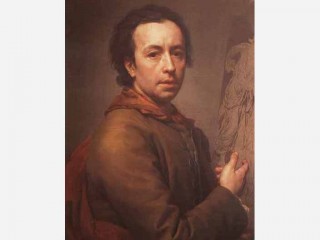
Anton Raphael Mengs biography
Date of birth : 1728-03-22
Date of death : 1779-06-29
Birthplace : Aussig, Bohemia
Nationality : German
Category : Arts and Entertainment
Last modified : 2010-12-17
Credited as : Artist painter, one of the precursors to Neoclassical painting,
The artistic theories as well as the works of the German painter Anton Raphael Mengs (1728-1779) were influential in the rejection of baroque ideas and the triumph of neoclassicism which took place in the late 18th century in Rome.
Anton Raphael Mengs was born in Aussig, Bohemia, on March 22, 1728, the son of a painter, Ismael Mengs, whose pupil he became. Taken to Rome to study with Marco Benefial and Sebastiano Conca from 1741 to 1744, Anton Raphael was said to have sometimes been locked into the Stanze of Raphael in the Vatican overnight by his father to make him copy the master's works—a stark but not untypical example of 18th-century pedagogy.
In 1744, living in Dresden, the 16-year-old artist produced pastel portraits of great accomplishment, particularly of members of the Saxon court. Appointed Saxon court painter in 1746, Mengs soon returned to Rome to continue his studies of ancient and Renaissance art. There he converted to Catholicism, married, and established himself as one of the leading painters of the city, at that time the most international artistic center of Europe. His study of ancient sculpture and of the masters of the High Renaissance, Michelangelo, Raphael, and Correggio, became the basis for his personal style. His friendship with Johann Joachim Winckelmann, the celebrated proponent of a return to the "noble simplicity and quiet grandeur" of ancient art, influenced most of his artistic theories. Yet, in spite of this lofty and often overly intellectualized classicism, Mengs retained some of the charming vitality and freshness of the rococo, notably in his portraits.
In both the ceiling fresco Apotheosis of St. Eusebius (1757) for the church of S. Eusebio, Rome, and the ceiling fresco Parnassus (1761) for the Villa Albani, Rome, Mengs sought to avoid baroque qualities and emphasize his classicistic doctrines, without really succeeding. Ostentatiously based on his study of classical sculpture, antibaroque in its concept, the Parnassusis one of his less appealing works, in spite of its tremendous fame and influence.
In 1761 Mengs was called to Madrid, where he was appointed court painter and worked feverishly, producing frescoes for the royal palaces of Madrid and Aranjuez, as well as many religious paintings, allegorical works, and portraits, all immensely successful, until total exhaustion forced him to stop for a rest in 1768. Back in Rome the following year, he painted the ceiling fresco Allegory of History and Time of the Camera dei Papiri in the Vatican Library, a work of much greater significance than the Parnassus, foreshadowing, as it does, the allegorical and historical painting of the coming century.
Mengs returned to Madrid in 1774 for yet another period of work for the Spanish court. His last 2 years were spent in Rome, where he died of tuberculosis on June 29, 1779.
Mengs is discussed in Fritz Novotny, Painting and Sculpture in Europe, 1780-1880 (1960), and Eberhard Hempel, Baroque Art and Architecture in Central Europe (1965).
















